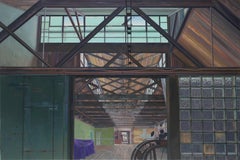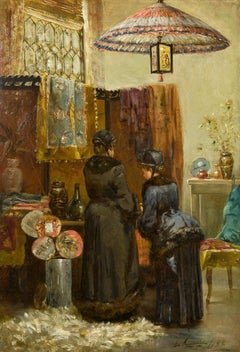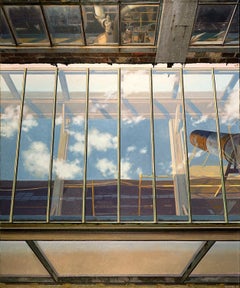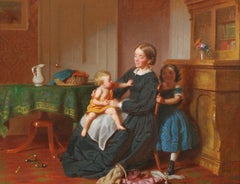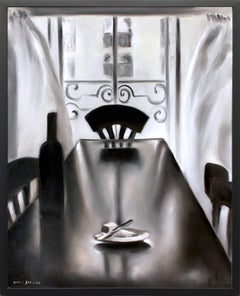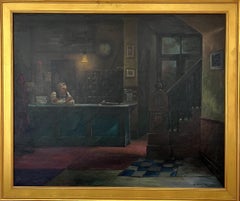Hirschl & Adler Interior Paintings
to
2
1
3
Overall Width
to
Overall Height
to
3
3
3
1
3
3
3
2
2
2
1
1
1
1
1
1
1
1
1
6
6
4
4
1
3
1
1
1
1
6
Interior of a Japanese House
By Harry Humphrey Moore
Located in New York, NY
Harry Humphrey Moore led a cosmopolitan lifestyle, dividing his time between Europe, New York City, and California. This globe-trotting painter was also active in Morocco, and most importantly, he was among the first generation of American artists to live and work in Japan, where he depicted temples, tombs, gardens, merchants, children, and Geisha girls. Praised by fellow painters such as Thomas Eakins, John Singer Sargent, and Jean-Léon Gérôme, Moore’s fame was attributed to his exotic subject matter, as well as to the “brilliant coloring, delicate brush work [sic] and the always present depth of feeling” that characterized his work (Eugene A. Hajdel, Harry H. Moore, American 19th Century: Collection of Information on Harry Humphrey Moore, 19th Century Artist, Based on His Scrap Book and Other Data [Jersey City, New Jersey: privately published, 1950], p. 8).
Born in New York City, Moore was the son of Captain George Humphrey, an affluent shipbuilder, and a descendant of the English painter, Ozias Humphrey (1742–1810). He became deaf at age three, and later went to special schools where he learned lip-reading and sign language. After developing an interest in art as a young boy, Moore studied painting with the portraitist Samuel Waugh in Philadelphia, where he met and became friendly with Eakins. He also received instruction from the painter Louis Bail in New Haven, Connecticut. In 1864, Moore attended classes at the Mark Hopkins Institute in San Francisco, and until 1907, he would visit the “City by the Bay” regularly.
In 1865, Moore went to Europe, spending time in Munich before traveling to Paris, where, in October 1866, he resumed his formal training in Gérôme’s atelier, drawing inspiration from his teacher’s emphasis on authentic detail and his taste for picturesque genre subjects. There, Moore worked alongside Eakins, who had mastered sign language in order to communicate with his friend. In March 1867, Moore enrolled at the prestigious École des Beaux-Arts, honing his drawing skills under the tutelage of Adolphe Yvon, among other leading French painters.
In December 1869, Moore traveled around Spain with Eakins and the Philadelphia engraver, William Sartain. In 1870, he went to Madrid, where he met the Spanish painters Mariano Fortuny and Martin Rico y Ortega. When Eakins and Sartain returned to Paris, Moore remained in Spain, painting depictions of Moorish life in cities such as Segovia and Granada and fraternizing with upper-crust society. In 1872, he married Isabella de Cistue, the well-connected daughter of Colonel Cistue of Saragossa, who was related to the Queen of Spain. For the next two-and-a-half years, the couple lived in Morocco, where Moore painted portraits, interiors, and streetscapes, often accompanied by an armed guard (courtesy of the Grand Sharif) when painting outdoors. (For this aspect of Moore’s oeuvre, see Gerald M. Ackerman, American Orientalists [Courbevoie, France: ACR Édition, 1994], pp. 135–39.) In 1873, he went to Rome, spending two years studying with Fortuny, whose lively technique, bright palette, and penchant for small-format genre scenes made a lasting impression on him. By this point in his career, Moore had emerged as a “rapid workman” who could “finish a picture of given size and containing a given subject quicker than most painters whose style is more simple and less exacting” (New York Times, as quoted in Hajdel, p. 23).
In 1874, Moore settled in New York City, maintaining a studio on East 14th Street, where he would remain until 1880. During these years, he participated intermittently in the annuals of the National Academy of Design in New York and the Pennsylvania Academy of the Fine Arts in Philadelphia, exhibiting Moorish subjects and views of Spain. A well-known figure in Bay Area art circles, Moore had a one-man show at the Snow & May Gallery in San Francisco in 1877, and a solo exhibition at the Bohemian Club, also in San Francisco, in 1880. Indeed, Moore fraternized with many members of the city’s cultural elite, including Katherine Birdsall Johnson (1834–1893), a philanthropist and art collector who owned The Captive (current location unknown), one of his Orientalist subjects. (Johnson’s ownership of The Captive was reported in L. K., “A Popular Paris Artist,” New York Times, July 23, 1893.) According to one contemporary account, Johnson invited Moore and his wife to accompany her on a trip to Japan in 1880 and they readily accepted. (For Johnson’s connection to Moore’s visit to Japan, see Emma Willard and Her Pupils; or, Fifty Years of Troy Female Seminary [New York: Mrs. Russell Sage, 1898]. Johnson’s bond with the Moores was obviously strong, evidenced by the fact that she left them $25,000.00 in her will, which was published in the San Francisco Call on December 10, 1893.) That Moore would be receptive to making the arduous voyage across the Pacific is understandable in view of his penchant for foreign motifs. Having opened its doors to trade with the West in 1854, and in the wake of Japan’s presence at the Philadelphia Centennial Exposition of 1876, American artists were becoming increasingly fascinated by what one commentator referred to as that “ideal dreamland of the poet” (L. K., “A Popular Paris Artist”).
Moore, who was in Japan during 1880–81, became one of the first American artists to travel to the “land of the rising sun,” preceded only by the illustrator, William Heime, who went there in 1851 in conjunction with the Japanese expedition of Commodore Matthew C. Perry; Edward Kern, a topographical artist and explorer who mapped the Japanese coast in 1855; and the Boston landscapist, Winckleworth Allan Gay, a resident of Japan from 1877 to 1880. More specifically, as William H. Gerdts has pointed out, Moore was the “first American painter to seriously address the appearance and mores of the Japanese people” (William H. Gerdts, American Artists in Japan, 1859–1925, exhib. cat. [New York: Hollis Taggart Galleries, 1996], p. 5).
During his sojourn in Nippon (which means, “The Land of the Rising Sun”), Moore spent time in locales such as Tokyo, Yokohama, Kyoto, Nikko, and Osaka, carefully observing the local citizenry, their manners and mode of dress, and the country’s distinctive architecture. Working on easily portable panels, he created about sixty scenes of daily life, among them this depiction of an interior of a dwelling. The location of the view is unknown, but the presence of a rustic rail fence demarcating a yard bordering a distant house flanked by tall trees, shrubs and some blossoming fruit trees, suggests that the work likely portrays a building in a city suburb or a small village.
In his book, Japanese Homes and Their Surroundings, Edward S. Morse (an American zoologist, orientalist, and “japanophile” who taught at Tokyo Imperial University from 1877 to 1879, and visited Japan again in 1891 and 1882) noted the “openness and accessibility of the Japanese house...
Category
Late 19th Century Interior Paintings
Materials
Oil, Wood Panel
Dye House
By John Moore
Located in New York, NY
Signed and dated (at lower right): MOORE 12
Category
2010s Contemporary Interior Paintings
Materials
Oil
Price Upon Request
The Japanese Corner
By Elliott Daingerfield
Located in New York, NY
A child of the American South, Elliott Daingerfield was born in Harper’s Ferry, Virginia, and raised in Fayetteville, North Carolina, where his father, C...
Category
19th Century American Impressionist Interior Paintings
Materials
Canvas, Oil
Distant Voices
By John Moore
Located in New York, NY
John Moore was born in St. Louis, MO in 1941. He received a BFA from Washington University in St. Louis (1966) and an MFA from Yale University (1968). Over a career spanning forty ye...
Category
2010s Contemporary Interior Paintings
Materials
Canvas, Oil
Clearing
By John Moore
Located in New York, NY
John Moore was born in St. Louis, MO in 1941. He received a BFA from Washington University in St. Louis (1966) and an MFA from Yale University (1968). Over a career spanning forty ye...
Category
2010s Contemporary Interior Paintings
Materials
Canvas, Oil
$115,000
Peek-a-Boo
By Seymour Joseph Guy
Located in New York, NY
In the latter half of the nineteenth century and into the first decade of the twentieth, New York City art aficionados could count on finding recent work of Seymour Joseph Guy hanging on the walls of the city’s major galleries. Primarily a genre artist, but also a portraitist, between 1859 and 1908 Guy showed more than seventy works at the National Academy of Design. From 1871 to 1903 he contributed over seventy times to exhibitions at the Century Club. From 1864 to 1887, he sent about forty pictures to the Brooklyn Art Association. A good number of these works were already privately owned; they served as advertisements for other pictures that were available for sale. Some pictures were shown multiple times in the same or different venues. Guy was as easy to find as his canvases were omnipresent. Though he lived at first in Brooklyn with his family and then in New Jersey, from 1863 to his death in 1910 he maintained a studio at the Artist’s Studio Building at 55 West 10th Street, a location that was, for much of that period, the center of the New York City art world.
Guy’s path to a successful career as an artist was by no means smooth or even likely. Born in Greenwich, England, he was orphaned at the age of nine. His early interest in art was discouraged by his legal guardian, who wanted a more settled trade for the young man. Only after the guardian also died was Guy free to pursue his intention of becoming an artist. The details of Guy’s early training in art are unclear. His first teacher is believed to have been Thomas Buttersworth...
Category
19th Century American Realist Figurative Paintings
Materials
Canvas, Oil
$110,000
Related Items
"First Meal in Paris" Parisian Impressionistic Oil Painting of Wine and Cheese
By Cindy Shaoul
Located in New York, NY
An interior scene depicting a bottle of wine and cheese plate atop a long dining room table in Paris. The breeze is being felt through the window, as t...
Category
2010s Contemporary Interior Paintings
Materials
Canvas, Oil
$2,500
H 31.25 in W 25.25 in D 1.5 in
Hotel Night Lobby. Large Mid-Century American Oil Painting.
Located in Marco Island, FL
A long and quiet night in the hotel lobby is depicted by Clyde Singer in this moody and still painting. Entitled Hotel Night Lobby (1947), Singer paints a moment of solitude during ...
Category
1940s American Realist Interior Paintings
Materials
Oil, Canvas
Roosters and Hens in a Barn 19th century E. Binam
Located in SANTA FE, NM
Roosters and Hens in a Barn 19th century
E. Binam (Belgian? 19th century)
Oil on wood panel
8 1/4 x 5 /12 (10 1/4 x 13 1/4 frame)
Though little is known about E. Binam, he was clea...
Category
1890s Realist Animal Paintings
Materials
Oil, Wood Panel
Chess Players WPA Depression Era Mid-20th Century American Scene Realism Modern
By Mervin Jules
Located in New York, NY
Chess Players WPA Depression Era Mid-20th Century American Scene Realism Modern. Signed upper right and verso 8 x 10 inches oil on board.
BIO
The son of a men's haberdasher, Mervin ...
Category
1930s American Realist Figurative Paintings
Materials
Oil, Board
$6,800
H 10 in W 12 in D 2 in
Portrait of a Man in Armchair, Mid Century Short Story Illustration
Located in Soquel, CA
Excellent figurative oil painting of a man seated in an armchair with papers strewn about the interior space by Charles Ross Kinghan (American, 18...
Category
1930s American Impressionist Figurative Paintings
Materials
Linen, Oil
$2,120 Sale Price
20% Off
H 24 in W 30 in D 0.75 in
Seated Figure In Boudoir
By Patricia Gillfillan
Located in Soquel, CA
Beautiful figurative oil on canvas of a woman seated in her boudoir by Monterey California-area artist Patricia Gillfillan (American, 1924-2016). Signed "Gillfillan" lower left. Unfr...
Category
1980s American Impressionist Figurative Paintings
Materials
Canvas, Oil
J.P. Morgan
Located in Storrs, CT
A 20th-century American School oil painting on board featuring American banker and financier J.P. Morgan (1837-1913) seated at his desk. Light streams throug...
Category
Mid-20th Century American Realist Interior Paintings
Materials
Oil
Home Office Interior
Located in Soquel, CA
Charming interior scene by a unknown artist (American, 20th Century). Slanting light enters the room from the viewer's left, illuminating part of the large desk at the center of the ...
Category
1990s Contemporary Interior Paintings
Materials
Canvas, Oil
White Horse Carousel, 1956 - Original Oil Painting On Linen
Located in Soquel, CA
White Horse Carousel, 1956 - Oil On Canvas
Oil painting of an empty carousel ride, a single white horse gleams in the center. Three doorways are seen to the right, with sunlight ema...
Category
1950s American Impressionist Figurative Paintings
Materials
Oil, Linen
$455 Sale Price
30% Off
H 18.25 in W 25.25 in D 0.5 in
"Old Shoemaker" Ashcan 20th Century Modernism 1924 California WPA Realism Worker
By Otis Oldfield
Located in New York, NY
"Old Shoemaker" Ashcan 20th Century Modernism 1924 California WPA Realism Worker. Signed “Otis Oldfield” lower left. 14 x 12 inches.
Exhibited: Galerie des Beaux Arts, San Francisco, CA, 1925
Provenance: Estate of the Artist
Born in Sacramento, CA on July 3, 1890, Otis Oldfield left high school at age 16 to work in a local print shop. In 1909 he arrived in San Francisco and enrolled at the Best Art School. After working for two years as a bellhop at the Argonaut Hotel and as a hat check boy at the Cliff House, he had saved enough money for further studies in Paris. In 1911 he sailed for France and enrolled at Académie Julian. Caught up in the activities of wartime Paris, he was an apprentice for a book...
Category
1920s American Realist Figurative Paintings
Materials
Canvas, Oil
Bellmen
By Paul G. Oxborough
Located in Greenwich, CT
Signed upper right
Unframed Dimensions: 16 x 20 inches
Framed Dimensions: 22 1/2 x 27 inches
Paul G. Oxborough studied at Minneapolis College of Art and Design and Atelier Lesueur,...
Category
2010s American Realist Figurative Paintings
Materials
Linen, Oil
Kit Impressionism Reclining Figure in Chair Interior Oil on Canvas 14" x 14"
Located in Houston, TX
Look for Free Shipping at Checkout
Kit is an American Impressionist figurative painting by Stuart Fullerton. The artist is known for his landscape, still-life, portraits and citys...
Category
2010s American Impressionist Figurative Paintings
Materials
Oil, Canvas
$2,200
H 14 in W 14 in D 1.5 in

